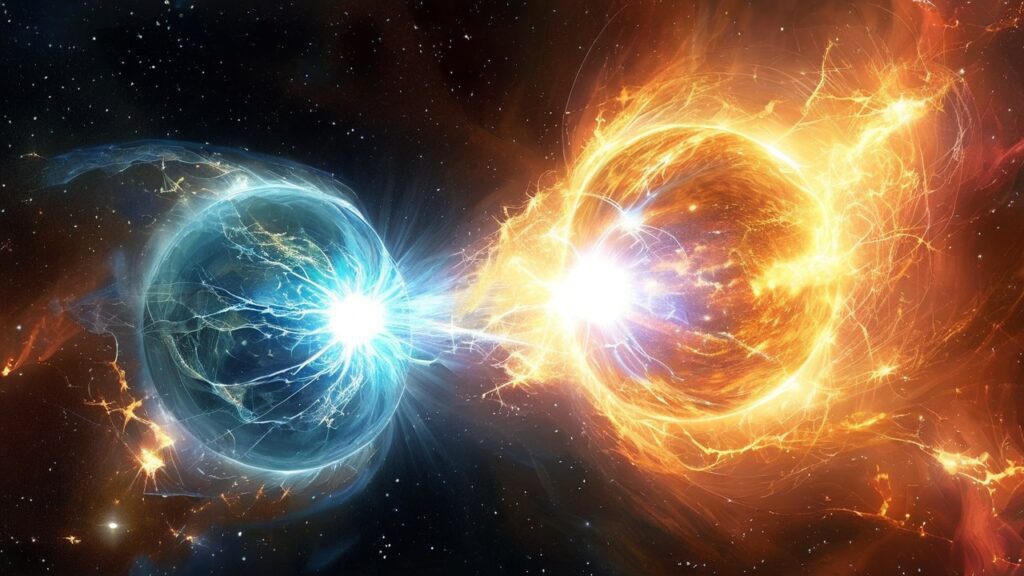Explore how gravitational waves reveal new properties of neutron stars, offering insights into the universe’s densest objects and their extreme behaviors.
For centuries, neutron stars have been one of the most mysterious objects in the cosmos. Formed from the remnants of massive stars after supernova explosions, these incredibly dense objects pack the mass of the sun into a sphere just 20 kilometers across. While scientists have long theorized about the nature of neutron stars, new discoveries have brought us closer than ever to understanding their elusive properties. Thanks to gravitational waves, a recent breakthrough has revealed hidden features of neutron stars that were previously undetectable.
In this article, we’ll explore the role of gravitational waves in these discoveries and examine what they could mean for our understanding of the universe.

The Role of Gravitational Waves in Astrophysics
Gravitational waves, first predicted by Albert Einstein in his theory of General Relativity, are ripples in spacetime caused by some of the most violent and energetic processes in the universe. Until recently, detecting these waves was a near-impossible task due to their incredibly faint signals. However, with the groundbreaking detection by LIGO (Laser Interferometer Gravitational-Wave Observatory) and Virgo detectors in 2015, scientists have gained an extraordinary tool to study cosmic phenomena.
These waves have allowed scientists to peer into the extreme environments around neutron stars and black holes, providing invaluable insights into their behavior. Gravitational waves are particularly useful in studying neutron stars because they help detect changes in their structure, size, and even the manner in which they merge with other objects. In essence, gravitational waves have given scientists a new “sense” to observe the universe.
Neutron Stars: The Universe's Extreme Beings

Neutron stars are among the densest objects in existence. A sugar-cube-sized portion of a neutron star weighs as much as a mountain on Earth. Their magnetic fields are trillions of times stronger than Earth’s, and they rotate at dizzying speeds. Some neutron stars, called pulsars, spin hundreds of times per second, emitting beams of radiation that can be detected by Earth-based telescopes.
Despite their small size, neutron stars hold immense gravitational pull. Understanding the physical properties of neutron stars has always been challenging because conventional observational methods fall short. Gravitational waves are now filling these gaps in our knowledge.
What the Latest Gravitational Wave Discovery Reveals
A recent study, using the power of gravitational waves, has unveiled properties of neutron stars that were previously hidden from view. This breakthrough comes from the observation of two neutron stars colliding, known as a neutron star merger. When these stars crash into each other, they release massive amounts of energy, shaking spacetime and producing gravitational waves that we can detect here on Earth.
Gravitational waves have allowed scientists to peer into the composition of neutron stars, particularly their crusts. The outer layers of neutron stars consist of incredibly dense matter, and their behavior during a merger is key to understanding how neutron stars evolve. By analyzing gravitational wave signals, scientists can now infer the strength and rigidity of neutron star crusts, which are made up of neutrons compressed to densities higher than that of atomic nuclei.
Impact: This helps researchers better understand the internal structure of neutron stars and provides clues about how nuclear matter behaves under extreme conditions.
The latest gravitational wave detections have allowed scientists to more precisely measure the mass and radius of neutron stars. Understanding the mass-radius relationship is essential to determining the “equation of state” for neutron stars—a mathematical description of how matter behaves inside these stars.
Impact: Knowing these properties helps scientists predict what happens in the ultra-dense core of a neutron star. For example, this can help determine whether exotic states of matter, such as quark matter, exist inside these stars.
When two neutron stars merge, their immense gravitational forces cause tidal deformations—similar to how the moon’s gravity creates ocean tides on Earth. These deformations affect the gravitational wave signal, allowing scientists to learn about the physical properties of the merging stars.

Impact: The tidal deformability of neutron stars gives insight into how matter is distributed within the star, helping to unlock the mystery of how such objects collapse into black holes after a merger.
Implications for the Future of Astrophysics
The detection of gravitational waves from neutron star mergers has opened new frontiers in astrophysics. For the first time, we have the ability to observe the formation of heavy elements, such as gold and platinum, which are produced in the intense conditions of these collisions. These insights offer answers to some of the most fundamental questions about the origin of elements in the universe.
In addition, the improved understanding of neutron star interiors will help scientists refine their models of nuclear physics. By studying these extreme environments, researchers can test theories that are impossible to replicate in laboratories on Earth.
By examining how matter behaves at densities far beyond anything found on Earth, scientists can test and refine their models of nuclear physics. Neutron stars offer a natural laboratory for studying matter at densities so high that protons and neutrons themselves may break down into their constituent quarks.
The behavior of neutron stars under extreme gravitational forces provides a unique opportunity to test Einstein’s theory of General Relativity. Gravitational waves generated by neutron star mergers allow scientists to observe how space and time behave under the influence of massive gravitational fields, offering a chance to refine or expand current models.
The Human Fascination with Cosmic Mysteries

Why are we so fascinated by neutron stars and gravitational waves? It’s because they challenge the limits of our understanding. Neutron stars represent the extreme edge of what we know about matter and gravity. They push the boundaries of physics and force us to rethink our assumptions about the universe.
The discovery of gravitational waves feels like opening a new book—one that has been waiting for us for eons. It invites us to explore questions that have perplexed scientists and philosophers for centuries. Where do we come from? What are we made of? And how does the universe work at its most fundamental level?
Gravitational wave astronomy has only just begun, and with each new discovery, we inch closer to answering these profound questions. As our technology improves, we’ll continue to detect more signals from neutron star mergers and other cosmic events, bringing us closer to understanding the workings of the universe.
How A SQUARE SOLUTION Fits into the Cosmic Puzzle
At A SQUARE SOLUTION, we believe that just like in science, digital innovation requires a curiosity-driven mindset. Gravitational waves are helping us explore the unknowns of the universe, and in the same way, we work to push the boundaries of digital experiences for our clients.
Our company thrives on embracing the latest technologies and discoveries to deliver cutting-edge solutions in digital marketing, app development, and web development. Just as gravitational waves have changed the landscape of astrophysics, we aim to redefine digital possibilities for our clients by constantly seeking new ways to innovate and evolve.
